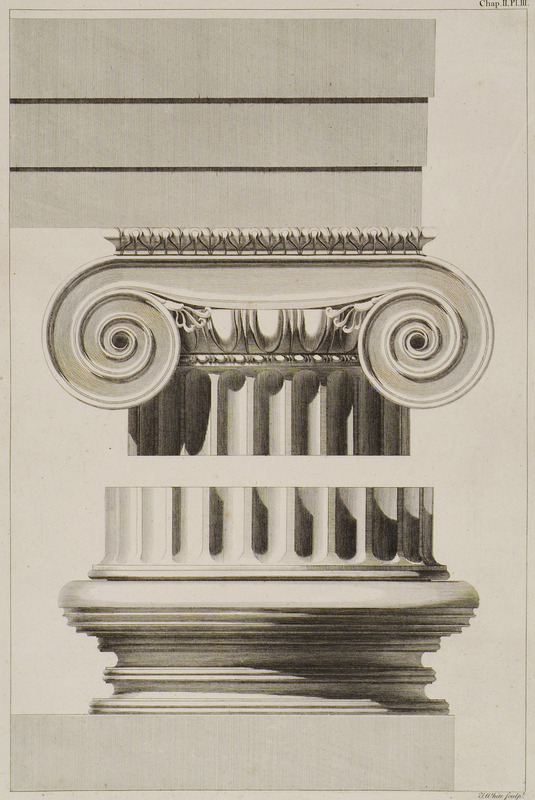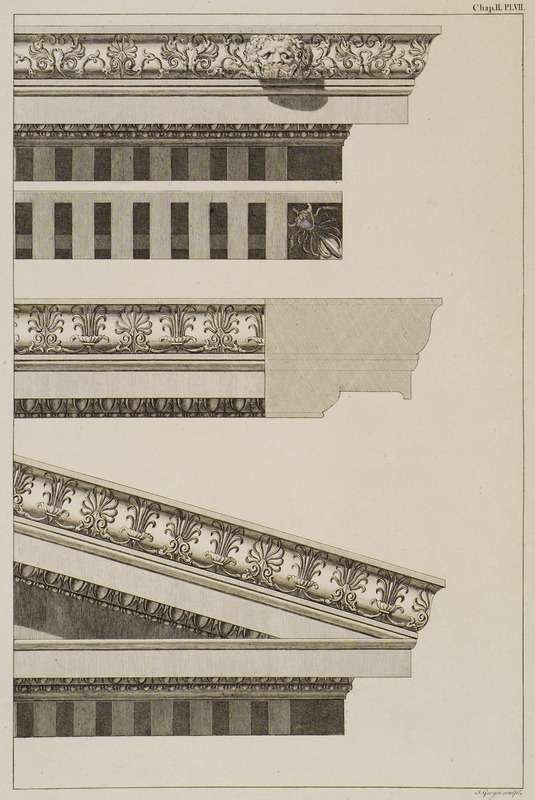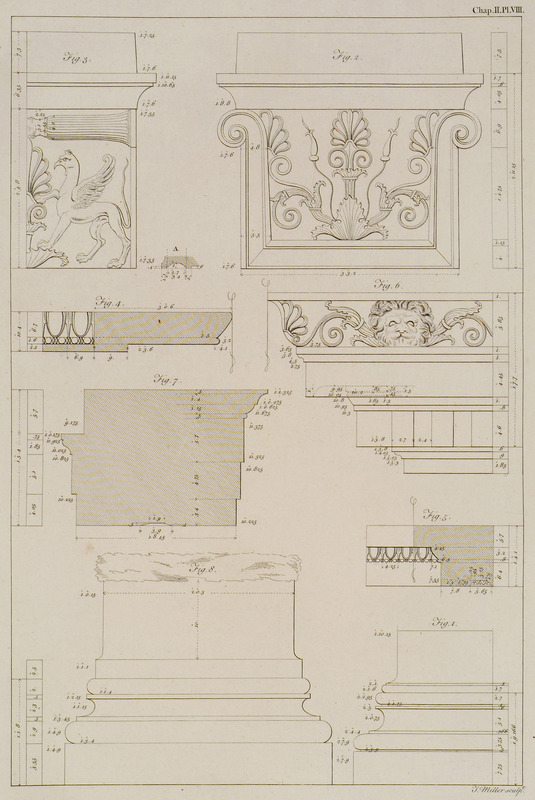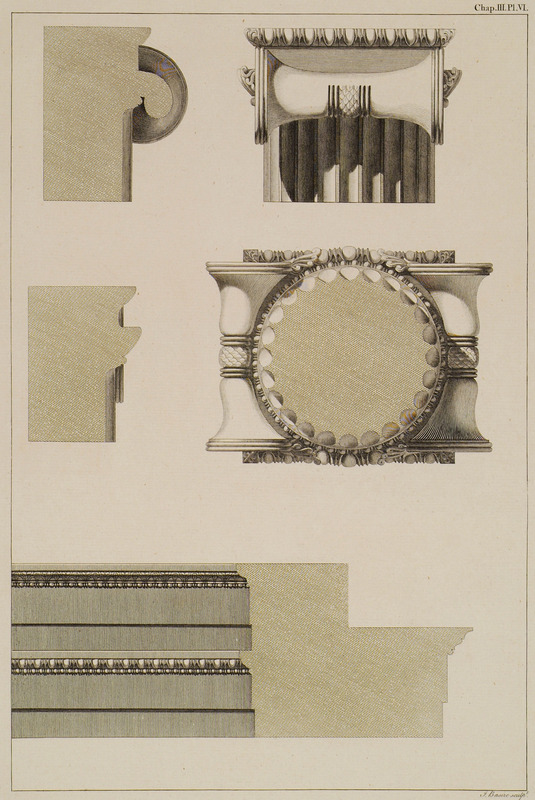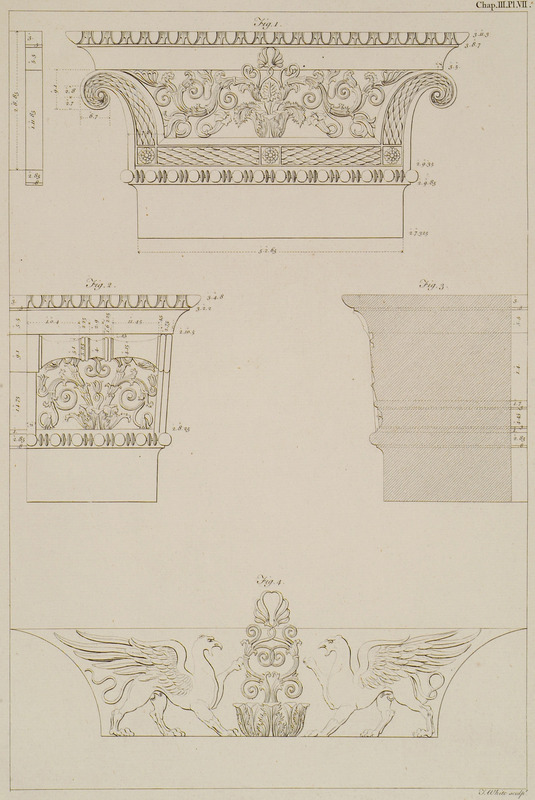Floor plans / Drawings (507 Subjects)
Mnemonic sketch of the geography of Athens.
Elevation of the Front of the Temple of Dionysus in Teos.
Temple of Dionysus in Teos. Fig. I: The Base of the Column, with the lower part of the Shaft. Fig. II: The Capital and Architrave, with the upper part of the Shaft of the Columns.Fig. III, A Section through the front of the Capital and Architrave. Fig. IV: A Section through the Profile of the Capital. Fig. V: The Contour of the Volute.
Capital and base of column from the Temple of Dionysus in Teos, with reconstructive drawing of the entablature.
Temple of Dionysus in Teos: Fig. Ι: The Cornice of the Temple. Fig. II An Architrave and Frize, of one piece of marble, decorated with a patera and festoons of Laurel, in a Turkish Burying-Ground by a Mosque at Segigeck [Sigacik]. Fig.III: A Section through the Sossit of the Architrave, which has a Compartmen surrounded with an Ovolo laid also flat. Fig. IV: A Pedestal and square Base, of one piece of white marble, near the South Gate at Segizeck [Sigacik].
Temple of Dionysus in Teos: The Contents of the preceding Plate shaded: Fig. Ι: The Cornice of the Temple. Fig. II An Architrave and Frize, of one piece of marble, decorated with a patera and festoons of Laurel, in a Turkish Burying-Ground by a Mosque at Segigeck [Sigacik]. Fig.III: A Section through the Sossit of the Architrave, which has a Compartmen surrounded with an Ovolo laid also flat. Fig. IV: A Pedestal and square Base, of one piece of white marble, near the South Gate at Segizeck [Sigacik].
Temple of Athena Polias in Priene: Fig. I: The uppermost Step and Base, with the lower part of the Shaft of the Column. Fig. II: The Capital and Fasciae of the Architrave, with the upper part of the Shaft of the Column.
Temple of Athena Polias in Priene: Fig. I: The uppermost Step and Base, with the lower part of the Shaft of the Column., Fig. II: The Capital and Fasciae of the Architrave, with the upper part of the Shaft of the Column. (shaded drawing).
Capital from the temple of Athena Polias in Priene: Fig. I: The Plan of the Capital…Fig. II: An Elevation of the Profile of the Capital. Fig.III: A Section through the Profile of the Capital. Fig.IV: A Section through the Front of the Capital. Fig. V: The Contour of the Volute… Fig. VI: A Section through the Torus of the Base, in which the Flutings and Profile are distinctly marked.
Capital from the temple of Athena Polias in Priene: The Plan, Elevation of the Profile, and Section of the Capital, shaded; Also the Abacus of the Capital and the Section on a larger Scale…Fig. I: The Plan of the Capital…Fig. II: An Elevation of the Profile of the Capital. Fig.III: A Section through the Profile of the Capital. Fig.IV: A Section through the Front of the Capital. Fig. V: The Contour of the Volute… Fig. VI: A Section through the Torus of the Base, in which the Flutings and Profile are distinctly marked.
Temple of Athena Polias in Priene: Fig. I: The Cornice of the Temple. Fig. II: A Section through the Cornice of the Pediment, with its Front annexed. Fig.III: A Section through the Architrave of the Temple, with its internal Face. Fig. IV: A Section through one of the Transverse Beams which supported the Lacunaria, with one of its Faces.
Temple of Athena Polias in Priene: The Cornices in the foregoing Plate shaded. Fig. I: The Cornice of the Temple. Fig. II: A Section through the Cornice of the Pediment, with its Front annexed. Fig.III: A Section through the Architrave of the Temple, with its internal Face. Fig. IV: A Section through one of the Transverse Beams which supported the Lacunaria, with one of its Faces.
Temple of Athena Polias in Priene: Architectural features such as base of column, capital, helix, cymatium and others. Fig. I: A square Base, with the lower part of a Column, found near each other, by the South East angle of the Temple. Fig. II: One of the Fronts of a Square Capital, which has four faces, and a Plinth upon the Abacus. A Section through the Stems of the Volutes, in front of the Capital. Fig. III: The Semi-profile of the same Capital. Fig. IV: A Section through the Cymatium of the Architrave. Fig. V: A Fragment of the Lacunaria...Fig. VI: The Cornice, which belonged to the Peristyle within the Peribolus. Fig.VII: A Section through an Architrave, belonging to the same Entablature as the above Cornice did, and found near it, among the ruins at the front of the Peribolus.
Temple of Athena Polias in Priene: Architectural features such as base of column, capital, helix, cymatium and others, (shaded drawing). Fig. I: A square Base, with the lower part of a Column, found near each other, by the South East angle of the Temple. Fig. II: One of the Fronts of a Square Capital, which has four faces, and a Plinth upon the Abacus. A Section through the Stems of the Volutes, in front of the Capital. Fig. III: The Semi-profile of the same Capital. Fig. IV: A Section through the Cymatium of the Architrave. Fig. V: A Fragment of the Lacunaria...Fig. VI: The Cornice, which belonged to the Peristyle within the Peribolus. Fig.VII: A Section through an Architrave, belonging to the same Entablature as the above Cornice did, and found near it, among the ruins at the front of the Peribolus.
Temple of Athena Polias in Priene: Fig. 1: The Entablature of the Temple restored [reconstructed representation], with a Section through the middle, showing its internal face. Fig. 2: The Ornament on the Sima upon a larger Scale… Fig. 3: An Architrave and Cornice, taken from Mr. Wood's measurements of this temple.
Temple of Athena Polias in Priene: Fig. I: A Cornice found at some distance, to the South East from the Peribolus. Fig. II: A Doric Capital and Entablature.Fig. III: The Projecture of the Triglyph from the Naked of the Frize.
Temple of Athena Polias in Priene: The Contents of the preceding Plate shaded. Fig. I: A Cornice found at some distance, to the South East from the Peribolus. Fig. II: A Doric Capital and Entablature.Fig. III: The Projecture of the Triglyph from the Naked of the Frize. (shaded drawing)
Temple of Apollo in Didyma: Fig. I: The uppermost Step, Base, and lower part of the external Columns of the Dipteros. Fig. II: The Capital and Architrave, with the upper part of the Shaft of the Column.
Temple of Apollo in Didyma: Fig. I: The Plan of the Capital…Fig. II: The Profile of the Capital. Fig. III: A Section through the Profile of the Capital. Fig. IV: A Section through the Front of the Capital. Fig. V: The Architrave of the internal Columns of the Diptero with the Frize, which supported the Lacunaria. Fig. VI: The Contour of the Volute, with as many of its Measures as could be collected.
Temple of Apollo in Didyma: The Contents of the foregoing Plate shaded, with a Section through the external Architrave of the Dipteros, also its internal Face and that of the Frize annexed. Fig. I: The Plan of the Capital…Fig. II: The Profile of the Capital. Fig. III: A Section through the Profile of the Capital. Fig. IV: A Section through the Front of the Capital. Fig. V: The Architrave of the internal Columns of the Diptero with the Frize, which supported the Lacunaria. Fig. VI: The Contour of the Volute, with as many of its Measures as could be collected.
Temple of Apollo in Didyma: Fig.I: The Front of the Ionic Capital of a Pilaster, with the upper part of the Shaft. Fig. II: The Profile of the same Capital. Fig. III: A Section through the Front of the Capital. Fig. IV: Another Compartment in the Front of one of these Capitals.
Temple of Apollo in Didyma: Fig.I: The Front of the Ionic Capital of a Pilaster, with the upper part of the Shaft. Fig. II: The Profile of the same Capital. Fig. III: A Section through the Front of the Capital. Fig. IV: Another Compartment in the Front of one of these Capitals. (shaded drawing).
Plan of ancient theatre in Riniasa.
Plan of the Upper Gallery of Hagia Sophia. Illustration of the stages of Muslim prayer. Byzantine coins.
View and plan of the fortress of Aigosthena (Porto Germeno).
Corinthian capital from Actia Nicopolis.
Plan of the Parthenon.
Map of Istanbul and the Bosphorus strait. Plan of Hagia Sophia.
Plan of the Parthenon as a Christian church.
Plan and section plan of the Acropolis.









